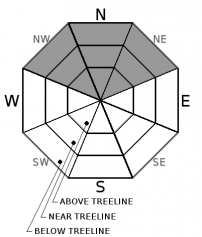| Wednesday | Wednesday Night | Thursday | |
|---|---|---|---|
| Weather: | Partly cloudy | Partly cloudy becoming clear | Sunny |
| Temperatures: | 45 to 50 deg. F. | 23 to 28 deg. F. | 49 to 54 deg. F. |
| Mid Slope Winds: | Southwest | Variable | West |
| Wind Speed: | 10 to 15 mph with gusts to 25 mph in the morning becoming light in the afternoon | Light | 10 to 20 mph with gusts to 30 mph |
| Expected snowfall: | 0 | 0 | 0 |
| Wednesday | Wednesday Night | Thursday | |
|---|---|---|---|
| Weather: | Partly cloudy | Partly cloudy becoming clear | Sunny |
| Temperatures: | 41 to 46 deg. F. | 25 to 30 deg. F. | 46 to 52 deg. F. |
| Ridge Top Winds: | Southwest | West shifting to the north after midnight | West |
| Wind Speed: | 15 to 25 mph with gusts to 45 mph | 15 to 20 mph with gusts to 40 mph | 15 to 25 mph with gusts to 35 mph in the morning increasing to 45 mph in the afternoon |
| Expected snowfall: | 0 | 0 | 0 |
























